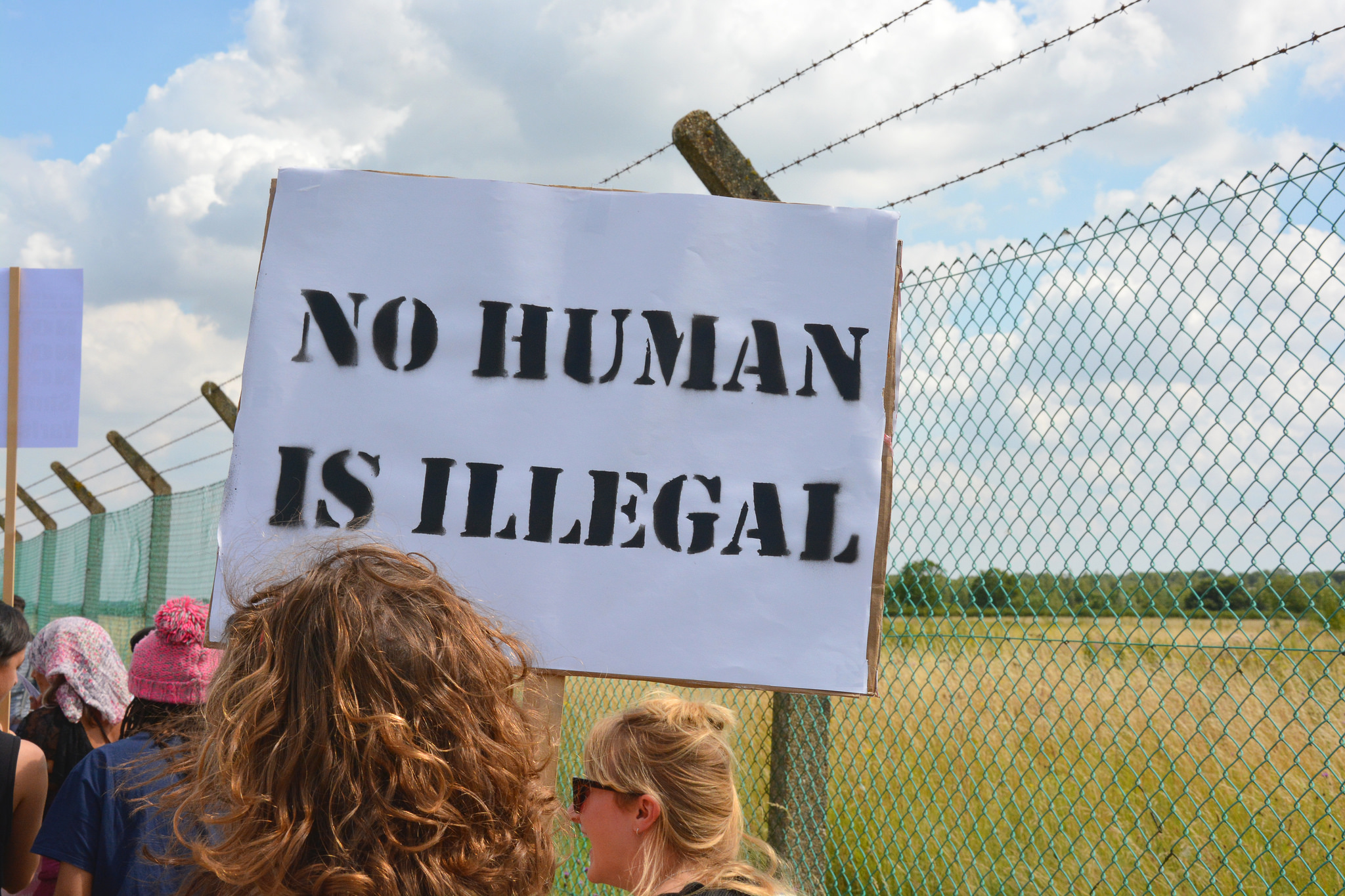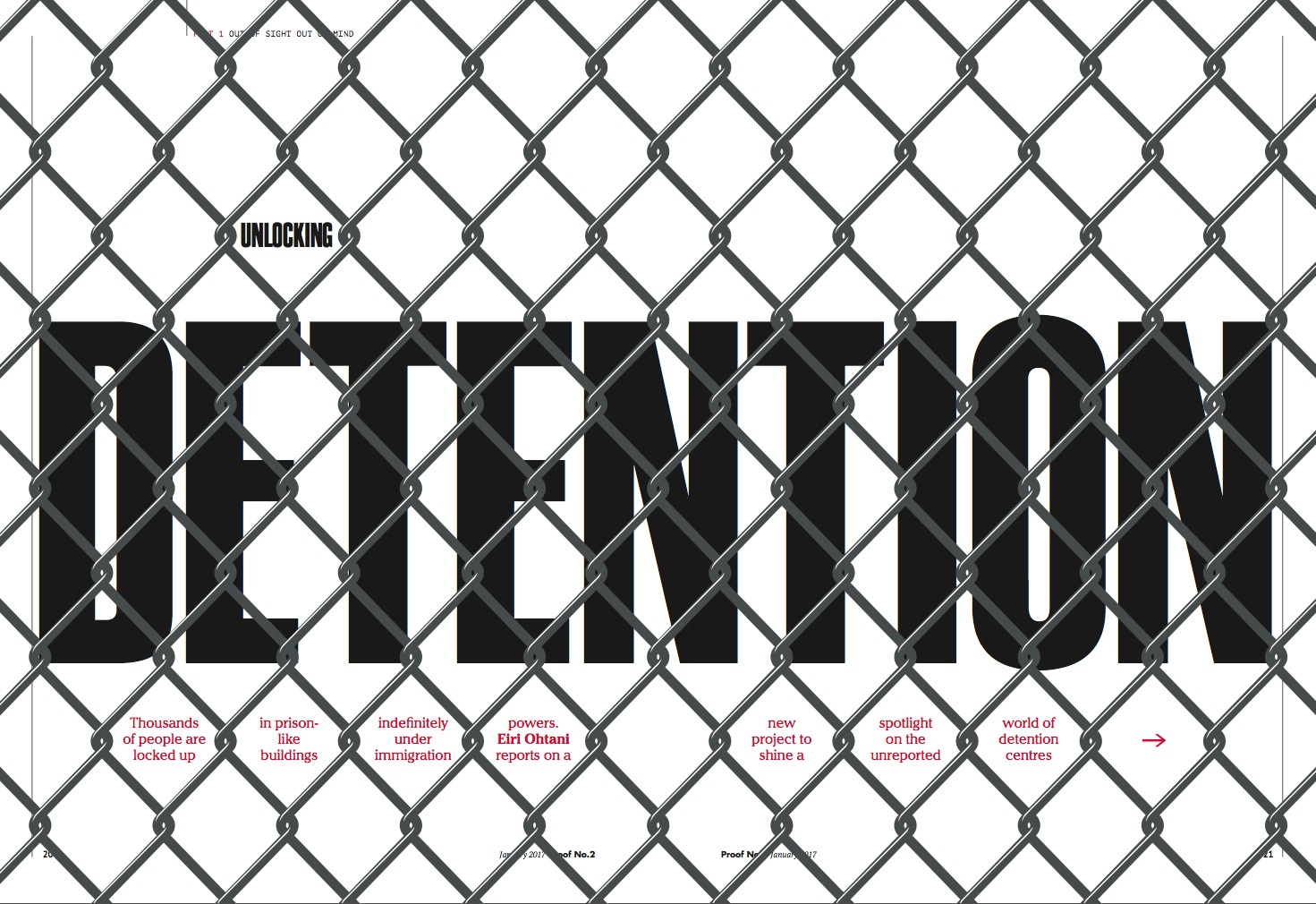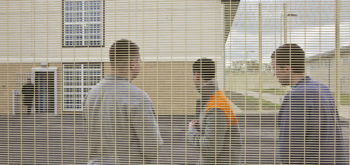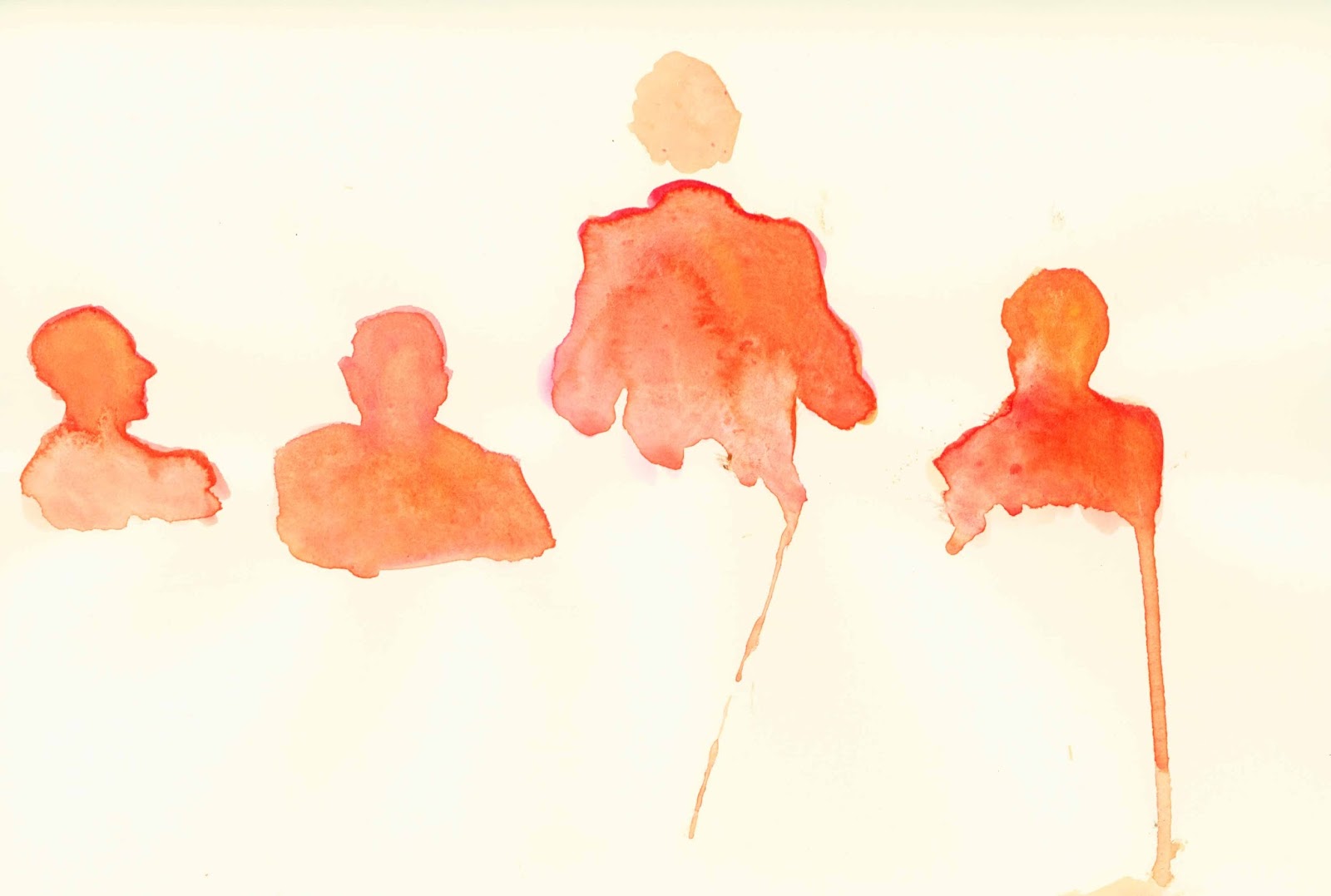Out of sight, out of mind: Unlocking detention
Thousands of people are locked up in prison-like buildings indefinitely under immigration powers. Eiri Ohtani reports on a project to shine a spotlight on the unreported world of detention centres. This is an edited version of an article that Appears in Proof magazine, issue 2. Buy here.
Unlocking Detention is a social media project that we wish we didn’t have to invent. Using tweets, blogs, recordings, photos and whatever comes in handy, it takes people on a virtual tour of the UK’s vast immigration detention estate.
During the tour, we will ‘visit’ each detention centre. Our stops include the remote Dungavel detention centre, a 45-minute drive from Glasgow, and the high-security Colnbrook detention centre, alongside the runway at Heathrow airport and right next to a Sheraton Hotel full of holidaymakers.
The tour highlights the impact of immigration detention on individuals and communities, something that is not as visible as the physical infrastructure of detention: gates, walls, fences, waiting rooms, visitors’ halls, cell-like rooms etc.
The tour lasts several months and ended in December 2016 coinciding with International Migrants Day.
Hidden in plan sight
We wanted to reveal the contradiction of immigration detention in our globalised world: that such a shocking and extraordinary practice has become ordinary and commonplace without the public even knowing. The subject of immigration detention only ever used to break into the mainstream media when there were deaths, disturbances, hunger strikes, sexual assaults and notable unlawful detention cases. That is less true nowadays because of growing political and public disquiet over the issue.
Such incidents are extremely disturbing. But they would be presented as inconvenient and momentary blips in an otherwise unassailable tide of violent immigration control. The blips are, however, forgotten the next day leaving behind the reality of immigration detention.
Perhaps this is understandable.
Tucked away in rows of unremarkable industrial buildings, forgotten on the edge of the country and abandoned in the middle of absolutely nowhere, detention centres exist firmly in the domain of invisibility, as if the government was deliberately trying to hide them. The people who are caught up in the system often don’t get much of a hearing.
With or without media attention, immigration detention continues every single day because it is accepted as a normal, invisible, part of immigration control. And for us, that indifference was equally, if not more, disturbing; the indifference that seems to say that the daily experience of almost 4,000 detained people doesn’t matter.
But it does matter, so Unlocking Detention makes a daily intervention, shining a light on what lies hidden beyond the sensational media headlines.
Wasted lives
The practice of depriving migrants of their liberty in the name of ‘securing our borders’ is not new. The Government’s power to detain migrants is derived from Immigration Act of 1971. The use of detention has increased dramatically over the past few decades, from several hundred bed spaces to nearly 4,000 bed spaces. Now we have eight immigration detention centres (their official name is Immigration Removal Centres) and several Short Term Holding Centres, which swallow over 30,000 migrants every year.
The UK runs a mixed economy of detention management; under contracts, some are run by the Prison Service while many are run by private security companies. The general rule is that those run by Prison Services use former prisons. Most of those run by private security companies are modern, purpose-built, high-security buildings. Regardless of who runs the centres or what the buildings’ origins are, common features are barbed wire and imposing metal gates. And the unbearable sense of anxiety, despair and wasted lives inside.
The Government’s official line is that detention is a last resort, mainly to effect removal from the UK, and must be used sparingly and for the shortest period possible.
The people who contributed to Unlocking Detention tell a different story. Despite it being a ‘last resort’, over 50% of those leaving detention are released to the community, making their detention incomprehensible. A small, but significant number of people endure extreme long term detention. UK uniquely in Europe has no time limit on immigration detention.
In his oral evidence to the Parliamentary Inquiry, one man (Souleymane) memorably described his three years of detention: ‘In prison, you count your days down. In detention you count your days up and up and up.’
A small team of dedicated people works closely together to make Unlocking Detention happen. In our last tour, we ran a weekly live Q & A session with a person who was detained in the centre we were looking at. Anyone curious could tweet a question, which we would put by telephone to the interviewee in detention (social media is obviously banned). We would then tweet back their reply.
‘Yaw’, who took part from Harmondsworth, explained: ‘I’ve been detained nine months. I never thought it would take this long. You can have a baby in nine months.’ Of 32,610 people who left detention between April 2015 and March 2016, almost one fifth, 19% (6,196), had been in detention for more than two months and 7% (2,325) had been in detention for over a year.
During our visit to Dungavel, the Scottish Visitors Group shared a series of photos of lonely countryside which they took on their long regular drive to the centre. In a dark car park, you can make out piles of snow of a harsh Scottish winter as well as the smiling faces of visitors bringing jumpers to those inside.
Nottingham and Notts Refugee Forum’s blog contribution tells a story of how the detention of one of its members brought people closer together than ever before:
‘When Imran was in detention he sent me a message in response to all his support from friends, he said: “We’re all a family now”.’
Detention does not stop at the gates of the detention centres.
‘Shariff’ asked in his letter to Harmondsworth detention centre: ‘Do you think that when I left Harmondsworth, Harmondsworth left me? I think about you guys every day.’ (See below for Shariff’s letter).
The dehumanising label of ‘detainees’ hides the huge variety of stories.
Some people are there because they overstayed their visas. Some came to the UK to seek asylum and their applications were refused. Some have lived in the UK for years, broke the law, finished their prison sentences and found themselves facing an uncertain future in a country they haven’t set their foot for decades.
Many have partners, parents, children and friends in the UK.
While people respond to detention differently, its impact is often devastating. And those who come into contact with the people in detention centres respond in different ways too. We visit, we campaign, we support, we speak to politicians, we demonstrate, we write. We connect.

Pic by Darren Johnson, www.idjphotography.com of August 15 2015 demo
Visibility does not mean accountability
The media does not have regular access to the detention centres. This is unsurprising given that even lawyers and support organisations do not have easy access (let alone the loved ones of those detained).
However, UK does have a well-established monitoring detention mechanism. HM Inspector of Prisons is a highly-regarded institution whose inspection reports provide vital information about the state of detention centres and people who are trapped in them, measured consistently against a specially-tailored framework.
There are also Independent Monitoring Boards whose local groups publish annual reports for each centre, though their varied approaches and depths of investigation don’t allow for an accurate understanding of the state of immigration detention across the country.
Information about immigration detention spills out into the public domain in other ways too. Statistics about immigration detention are made publicly available quarterly. Many NGOs produce reports, often based on the analysis of concrete evidence that is found through their daily work in detention.
These create a picture of a growing detention estate with malfunctioning safeguards that are meant to protect vulnerable people.
Visibility does not automatically lead to accountability. If ‘justice must be seen to be done’, should we not be also saying ‘injustice must be seen and acted upon’?
So Unlocking Detention makes detention visible and calls for action. We have encouraged and supported the people around the country who got involved with Unlocking Detention to submit evidence to the detention inquiry, to lobby MPs, and show solidarity with people in detention through messages and photos. In the first year, hundreds of people tweeted selfies of their call for a time limit and other calls for change.
Time for change
The political landscape surrounding detention has changed since we started Unlocking Detention in 2014. In March 2015, the Parliamentary Inquiry into the use of immigration detention delivered a damning conclusion that UK detains far too many people for far too long. A radical overhaul of the entire system was recommended, starting with the introduction of a 28-day time limit.
In February 2016, the government-commissioned Review into the Welfare in Detention of Vulnerable Persons urged the government to begin the process of reducing detention ‘boldly and without delay’.
Meanwhile, Haslar and Dover detention centres were unceremoniously closed down, the size of demonstrations outside the detention centres grew and previously reticent Parliamentarians became consistently vocal in demanding change.
One tangible result of all of this is the limited but significant concessions gained through the passage of the Immigration Act 2016: a 72-hour detention time limit for pregnant women and automatic judicial oversight every four months for some categories of detained migrants.
This could be the beginning of more changes to come. But with the continuing policy of the hostile environment for migrants and the emboldened anti-immigration and xenophobic mood after the Brexit vote, the future remains uncertain.
We have a long way to go before we see a migration system that doesn’t rely on detention. We believe that there must be a way in which people can complete their entire immigration procedures in the community with dignity.
In the meantime, Unlocking Detention will continue to act as a platform for people and communities to speak up and call for change. People like William, who said:
‘I think about lots of guys I met in detention. I can picture their faces. I have a gallery of faces in my head. There are certain things that trigger different faces. Whenever I look at my SIM card, for example, I think about the guy that gave it to me in detention. When I look over my Home Office paper, my mind always goes back to Campsfield and some of the people I was with when I first received them. I have one jumper that one guy gave me because it was cold. Whenever I wear it I am with him.’
To find out more about Unlocking Detention, visit www.unlocked.org.uk and follow @DetentionForum
Hidden world of immigration detention
 What is immigration detention?
What is immigration detention?
It is the practice of holding people who are subject to immigration control in custody, while they wait for permission to enter or before they are deported or removed from the country. It is an administrative process, not a criminal procedure. Migrants are detained on the decision of an immigration official as opposed to a court or a judge. Unlike most other European countries, there is no time limit on immigration detention in the UK.
In numbers
- 8: number of Immigration Removal Centres where people are held indefinitely – plus four Short Term Holding Facilities where they can be held for up to seven days
- 3,418: number of people in detention in 2015
- 32,053: number of people entering detention in 2015
- 216: number of people who had been in detention for 12 months or more in 2015
- 155: number of children entering detention in 2015
- 373: number of people held in prisons (solely under immigration powers in the Immigration Act 1971 or UK Borders Act 2007) at 29 June 2015
- £70,000: how much it costs the taxpayer for one year of detention in Colnbrook
Yarl’s Wood: a ‘place of national concern’
In August 2015 the then chief prisons inspector Nick Hardwick described Yarl’s Wood, in Bedfordshire, as a ‘place of national concern’. It holds more than 350 female detainees. Whilst 443 women held at the centre were removed from the UK in the six months before the inspection, just over twice that number were released back to the community. Of 99 pregnant women held at Yarl’s Wood over the last year, only nine were removed.
Fifteen detainees had been held for between six months and a year. Four were detained for more than a year, the longest being 17 months.
Indefinite Detention – #Time4aTimeLimit
The UK is the only country in the European Union not to have an upper time limit on detention. The Home Office policy states, ‘detention must be used sparingly, and for the shortest possible period necessary’.
In March 2015 a cross-party group of MPs and peers called on immigration detention to be capped at 28 days. ‘We detain a lot of people, some for a very long time, all with huge uncertainty, and we have very limited processes for individuals to challenge that detention,’ said the Liberal Democrat MP Sarah Teather, who chaired the inquiry. ‘We believe the problems that beset our immigration detention estate occur quite simply because we detain for too many people unnecessarily and for far too long.’
Earlier this year during the passage of Immigration Act 2016 peers voted by 187 to 170 that detention must be limited to 28 days, except when a court decides otherwise. The Immigration Act introduces automatic judicial oversight on the UK’s use of immigration detention for the first time and a 72-hour time limit on the detention of pregnant women.
A Letter to Harmondsworth: ‘I saw people swallow razor blades’
Dear Harmondsworth IRC,
I know you are very busy at the moment but I have a few questions about the three months you held me in detention.
Why do the rooms in Harmondsworth feel like you are living in a coffin? Do you do this on purpose?
If Harmondsworth is not a prison, then why does it look like a prison? Why does it smell like a prison? Why do the guards treat you like a prisoner?
Why were people allowed to work in Harmondsworth but outside detention we are not allowed to work?
Why do you have a department called ‘Healthcare’ when it does not offer ‘health-care’?
You lost all my medicine and my individual case file. Where did they go? Did someone steal them? Is there a black hole somewhere in Harmondsworth?
Do you have anything else in healthcare other than paracetemol?
I went to get a Rule 35 (requiring that a doctor’s report on the case of any detained person whose health is likely to be adversely affected by detention) from your doctor. He said: ‘Ok, what do you want me to put?’ ‘You are the doctor, you need to say what is wrong with me,’ I said. He said, ‘If I do that we’ll be here for three, four hours.’
In the end, he wrote something very quickly. In court, the judge didn’t even look at it. Can you tell me – what is the point of Rule 35 if this is the kind of doctor you employ to do it?
Why do you not bring in doctors from outside? Have you ever been seen by a NHS doctor? Can you tell the difference in the standard of care?
Why did no-one in Harmondsworth try to help me understand the asylum process? Why did no-one even tell me I was on the Detained Fast Track? Do you give your staff orders to confuse us on purpose? Or maybe they just don’t know anything about the immigration system either?
What is the Detained Fast Track for? Has it got anything to do with a fair trial? What does it say about the British justice system? If you are going to reject 99% of cases, why even put us through the stress of the system?
I got five minutes with my solicitor before my asylum interview – do you think this is enough time to prepare for the most important interview of your life?
Superman could not prove his innocence on an appeal in just two days, from the inside of a cell. Do you think ‘North Africa’ is one country? Do you think an Algerian interpreter can effectively translate for an Egyptian, like me?
I saw people slash their necks and swallow razor blades in Harmondsworth – if detention is designed to make us suffer so we agree to go home, do you consider this as a success?
Once in detention, I was feeling bad in my cell and I banged the door to ask for help. Four or five men arrived, acting like they were all Jean Claude van Damme. They shoved me to the floor, handcuffed me and took me to isolation. They kept me there for two days. They said my ‘behavior’ was the problem. Do you train your staff to be violent and aggressive?
Do you think that when I left Harmondsworth, Harmondsworth left me? I think about you guys every day.
I look forward to hearing your answers.
Yours sincerely,
Shariff.







